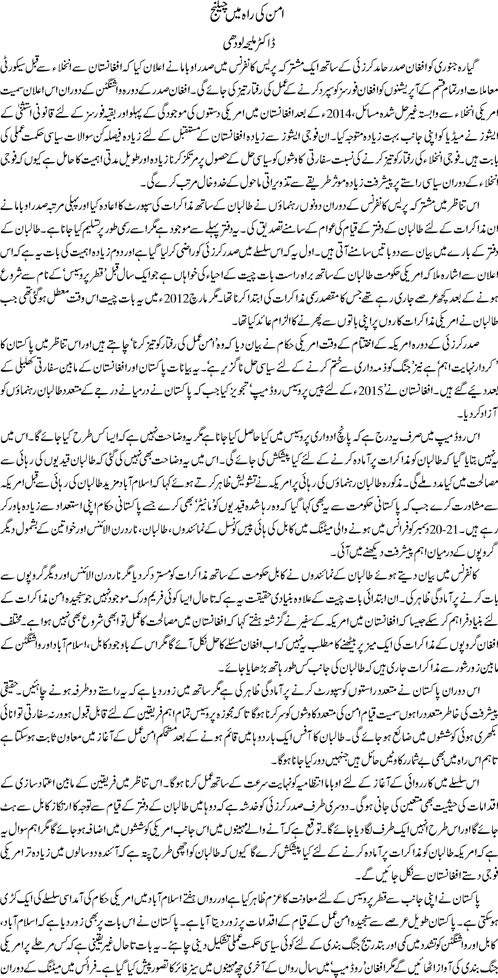Challenges on the Path to Peace
(Pakistan) on 23 January 2013
by Dr. Maliha Lodhi (link to original)
In addition to the fact that both leaders supported negotiation with Taliban, President Obama confirmed, for the first time ever, the presence of the Taliban office. Although this office has already existed for a long time, it has never been officially accepted. This announcement made two things clear: first, President Karzai has been persuaded to acknowledge the Taliban’s office; second, the American government wants to talk directly with the Taliban. However, one year ago, under the title of the “Qatar Process”, similar dialogues were started for a short time, which also had the purpose of having a formal discussion with Taliban. These talks ended in March 2012, when the Taliban accused the American authorities of not following through on their promises.
At the end of President Karzai’s visit to America, U.S. officials stated that they wanted to “pick up the pace on the peace process.” They added that, in this situation, “Pakistan’s role is very important” and in fact “a political solution that will end the war without distributing responsibility is not sufficient.”* These statements were given after some political disturbance between Afghanistan and Pakistan. Afghanistan suggested a “road map for peace process for 2015” while Pakistan released many midlevel Taliban leaders.
The five steps in the road map mentioned goals, but didn’t explain the process of achieving those goals. Furthermore, it didn’t describe what is being offered to Taliban for being part of negotiations. Similarly, it did not draw the link between the release of Taliban prisoners and the reconciliation process. America showed its concern on releasing Taliban members and asked Islamabad to consult before taking any such action. It has also been requested that the government of Pakistan monitor those Taliban members who are released, which, according to the Pakistan government, is beyond its capacity. On the other hand, there was some progress: The members of the Kabul High Peace Council, the Taliban, the Northern Alliance, women’s organizations and other groups made some encouraging steps at the meeting on Dec. 20-21 in France.
The Taliban’s representatives agreed to meet the Northern Alliance and other groups at the conference, but refused to talk to the Kabul government. Instead of relying on those initial meetings, a proper framework is needed as a base for peace negotiations. An American ambassador also indicated that the process of reconciliation has not been started yet in Afghanistan. Being able to meet with different Taliban groups doesn’t mean Afghanistan will find a solution for its peace issues. Despite that, Islamabad, Washington and Kabul are finding ways to involve the Taliban in the peace negotiations.
Pakistan is showing its support but also insisting that the process should be mutually beneficial for both countries. The sustainable solution requires procedures that are acceptable to all the parties. Without this assurance, all the diplomatic energy will be wasted in futile efforts. If the Taliban’s office is formed in Doha, it could help in providing a better initiative for the peace process. However, many barriers need to be removed first.
In this regard, Obama’s government needs to accelerate the process. In addition, there is a need to take several measures in order to build confidence among the different parties. Yet President Karzai is under the impression that the Taliban office will divert the attention of stakeholders from Kabul to Doha. It is expected that America will increase its efforts in the coming months, as the Taliban knows that many American troops will leave Afghanistan in the next two years; it is important to know what America will offer the Taliban in order to convince them to agree to the negotiations.
Pakistan has been supporting peace measures in the region for a long time. The country is determined to support the Qatar process; the upcoming visit of American officers to the country would be part of these developments. Furthermore, Pakistan is also indicating that Islamabad, Kabul and Washington should find additional political strategies to ensure peace in the region. Although the announcement of a ceasefire by America is not yet confirmed, Afghanistan’s road map shows that this target could be achieved during the last six months of the current year. On the other hand, the Taliban have repeated their basic demands: the withdrawal of foreign troops, the alterations of the constitution according to Islamic principles, the release of Taliban leaders and the removal of their names from the United Nations control list. As the deadline of 2014 nears, there is the need for amendments to the peace negotiations. All stakeholders should unite and co-operate for the common interest of Afghani security and peaceful political change. No one, including Pakistan, wants the year 2014 to resemble the year 1989, when the West abandoned Afghanistan to serve its own interests after the Soviet withdrawal.
*Editor’s Note: Although accurately translated, these quotations could not be verified.

